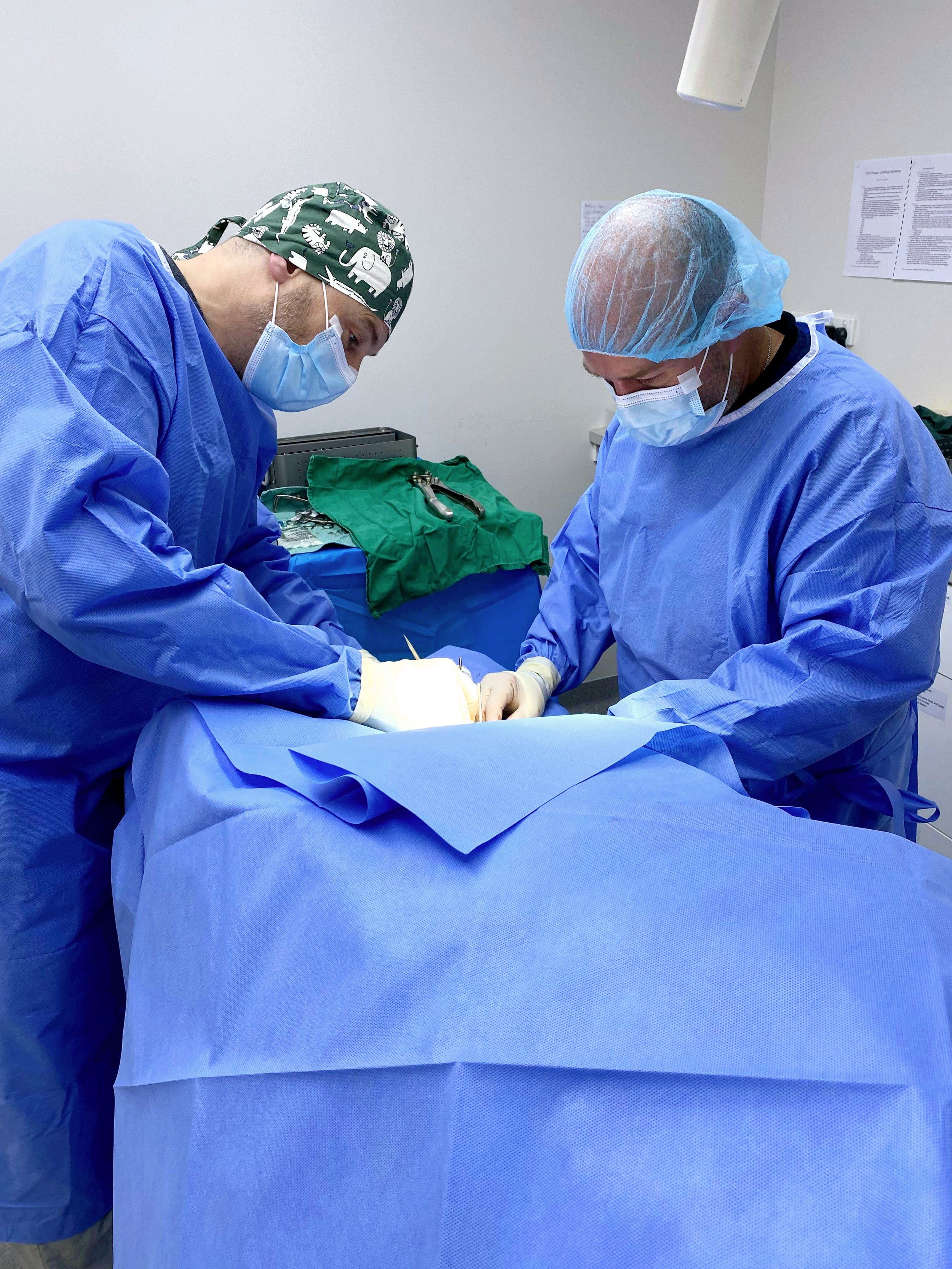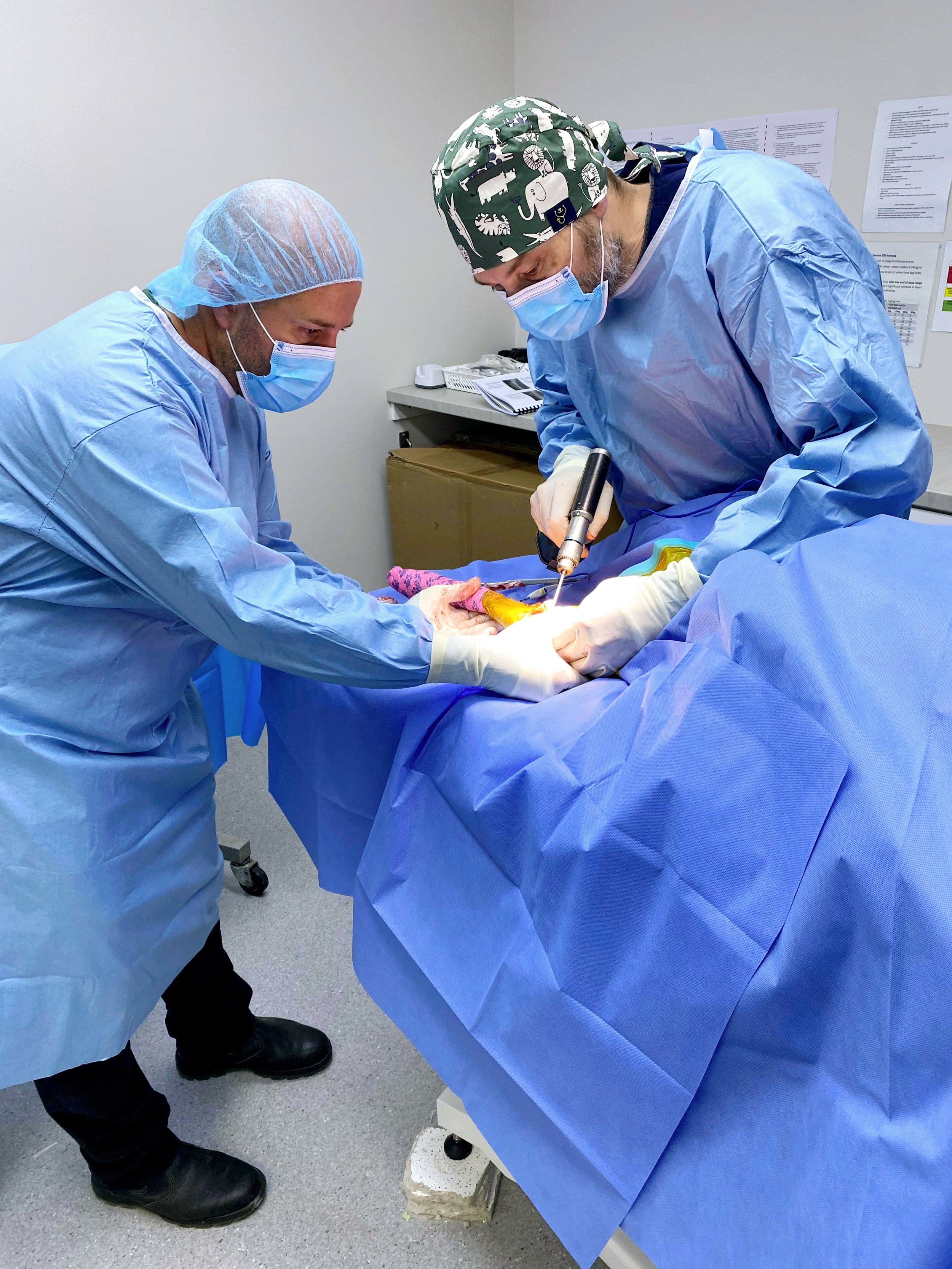
TPLO Surgery
TPLO Surgery
Cranial cruciate ligament rupture in the knee is one of the most common causes of hind limb lameness in dogs. It is especially common in at risk breeds such as Labradors, Retrievers, Boxers, Rottweilers and American Staffordshire terriers.
The cruciate ligaments are found within the knee joint and are responsible for keeping the joint stable and preventing movement of the femur (thigh) in relation to the tibia (shin). If these ligaments become damaged or break, the joint becomes unstable, leading to cartilage damage and the development of osteoarthritis.
The risk of cranial cruciate ligament injury in dogs increases with age as the ligament can be prone to wear and tear over time, ultimately leading to rupture. A dog’s body weight is also an important predisposing factor. As a result, TPLO surgery is one of the most common orthopedic surgical procedures performed on dogs.
WHAT DOES TPLO STAND FOR?
Tibial Plateau Leveling Osteotomy
WHAT IS A TPLO?
A tibial plateau levelling osteotomy is a surgical procedure used to stabilise the joint when the cranial cruciate ligament ruptures. It involves cutting the top of the tibia and rotating it and then fixing the fragment in place with a plate and screws. By doing this, the sliding forces are neutralised and the joint is biomechanically stable during walking and running.
WHAT IS THE CAUSE OF CRUCIATE LIGAMENT INJURY IN DOGS?
The most common cause of cruciate ligament injury is cruciate disease which is a chronic conditon, that over time causes the cruciate to wear and start to breakdown. This deterioration eventually makes the ligament so weak that it breaks. On occasion, cruciate ligaments can also rupture during a traumatic incident.
WHAT ARE THE SIGNS THAT MY DOG MIGHT NEED A TPLO?
Limping is the most common sign of an injured cranial cruciate ligament. Very often the limp will improve over a few weeks but does not go back to normal. Your pet may stand with the toes of the affected limb touching on the ground and not fully weight bearing. Significant muscle wasting can occur in the affected limb and when pets sit, they will often sit with the affected limb out to the side. Once the ligament is torn, it cannot heal and without surgery, the deterioration will cause chronic change and inflammation resulting in osteoarthritis and persistent pain.
HOW DO YOU DIAGNOSE CRANIAL CRUCIATE LIGAMENT RUPTURE?
Before any surgery is attempted, a thorough physical examination by a veterinarian is required to assess the patient's level of pain and the stability of the joint. Joint instability can often be palpated in conscious pets but in most cases sedation is required to confirm the instability. Thickening on the side of the knee joint can also be palpated in chronic cases.
WHAT DOES IT INVOLVE?
Once a suspected diagnosis of cranial cruciate ligament rupture is made, pets are booked in to have xrays done. These xrays are essential to get the correct measurements of the tibia so that the correct plate and screws can be selected prior to surgery. High quailty xrays are also essential to evaluate for any underlying issues such as hip dysplasia or spinal disease that might influence the outcome of surgery.
WHAT IS THE AIM OF THE PROCEDURE?
This surgery aims to improve the function and stability of the knee joint, allowing the dog to regain mobility and reduce pain caused by the cranial cruciate ligament injury.
WHAT CAN I EXPECT IF MY DOG UNDERGOES TPLO SURGERY?
TPLO surgery is a major orthopaedic procedure and there is a significant period of rehabilitation following the procedure. Full rehabilitation takes up to 12 weeks and there are step wise recommendations and limitations as to how much movement and exercise is allowed each week following the procedure. Rechecks are done 3 days and 7 days after the procedure to make sure the healing process is going according to plan and that there is nothing to worry about. Patients will also stay overnight after their surgery and will have a pain killing drip giving pain medication at a constant rate infusion.
WHAT IS THE RECOVERY TIME?
Initial recovery from the surgery takes a few days. Once the patient is through the first few days, slow return to normal activity over the next 8-12 weeks occurs.
WHAT ARE THE RISKS AND COMPLICATIONS?
The complication rate for a TPLO procedure is fairly low with 3-4% of procedures developing complications. Most commonly, infections of the surgery site occur which can be treated with appropriate antibiotic therapy. Mechanical and plate complications usually occur in animals that have been returned to exercise too quickly and have not allowed enough time for the bone to heal properly. These are usually managed with anti-inflammatory drugs and adequate rest and confinement. On rare occasions, revision surgery may be necessary if the plate or screws have been damaged.










